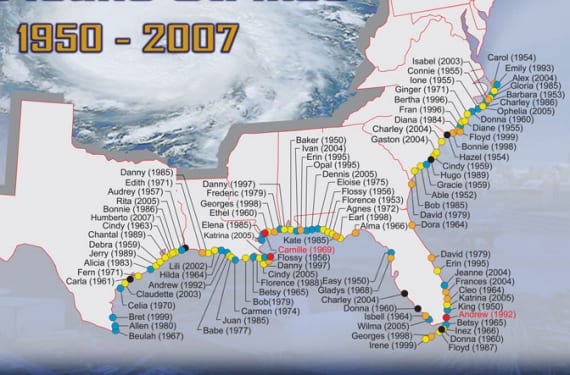
Hurricanes that struck the southwestern United States between 1950 and 2007
These days with the aftermath of the typhoon Haiyan o Yolanda (as it is known in the Philippines) will have aroused curiosity in many readers where these names come from, how and by whom they are determined and for what reason in some cases, like this one, they have more than one name. Some might even think, why aren't thunderstorms or the intense tornadoes that they sometimes produce named like that and reserved for when they reach hurricane or tropical storm status?
Throughout history, typhoons have received different names. Their classification has changed over the years to reach the list system used today by almost all world meteorological services (WMO, NHC, PAGASA, etc.).
For hundreds of years, hurricanes were named after the saint of the day they occurred ("San Felipe" in 1876 Puerto Rico). At the end of the XNUMXth century, an Australian meteorologist named them after politicians who did not like them. tropical cyclones. During World War II, women's names were attributed to them. Subsequently, the United States planned to name them in phonetic order, although the introduction of the new international phonetic alphabet led to a return to women's names.
Before 1950 the United States Military Meteorological Service was responsible for assigning a number to tropical storms. For example, the fifth tropical cyclone of the 1932 Hurricane season was named Number 5. In the following years the military phonetic alphabet (Able, Baker, Charlie, etc.) was used to assign names.
Later, in early 1953, tropical storms were given female names. Names that were listed in alphabetical order, giving the first tropical storm of the year a name beginning with A.
In 1978, both female and male names were included in the North Pacific storm name list. In 1979 the list of names of the Atlantic Basin increased, including also male and female names. Today, when a tropical disturbance escalates into a tropical storm with winds greater than 63 km / h (39 mph) the National Hurricane Center (NHC) gives it a name.
To determine which names to use, the member countries of the World Meteorological Organization (WMO) are constantly reviewing the lists, including common names for English-speaking, Spanish-speaking and French-speaking. The order of the male and female names alternates each year. for example, in 1995 the list started with Allison and in 1996 with Arthur.
Currently, there are 6 lists of tropical cyclone names, 21 names for Atlantic storms and 24 for storms in the northeast Pacific. In the Philippines it is PAGASA (Philippine Atmospheric, Geophysical and Astronomical Services Administration) as of 2001, uses four lists of 25 names. The names have to be short and easy to understand, do not forget that they can affect many countries. These lists are used on an annual rotating basis (the list used in 2011 was the same as in 2005, except for the names that were removed).
In the case that all the names of a list were used, exceeding 21 cyclones (24 in the northeast Pacific), the following ones begin to be named with the Greek alphabet: alpha, beta, and so on. In the case of the Philippines, PAGASA uses an auxiliary list of names when they exceed 25.
From these lists, on some occasions when a storm has been devastating and has caused numerous deaths, his name is proposed to be removed. This gesture of respect towards the victims also serves to avoid confusion in the insurance companies, the media, etc. For example in 2005 the Katrina or the Sandy in 2012 with other names like Andrew, Bob, Camille, David, Dennis, etc.
If a tropical storm originating in the Atlantic reaches the Pacific, it is given a new name. And in the case of Typhoon Haiyan, it was two different agencies that came up with those two different names. Typhoon Yolanda being the one established by PAGASA.
More information - Tacloban, typhoon Haiyan ground zero, Hurricane Sandy, one year anniversary: much to do, much to learn, The year 2013 will be the seventh warmest since there are records
Reference - NOAA